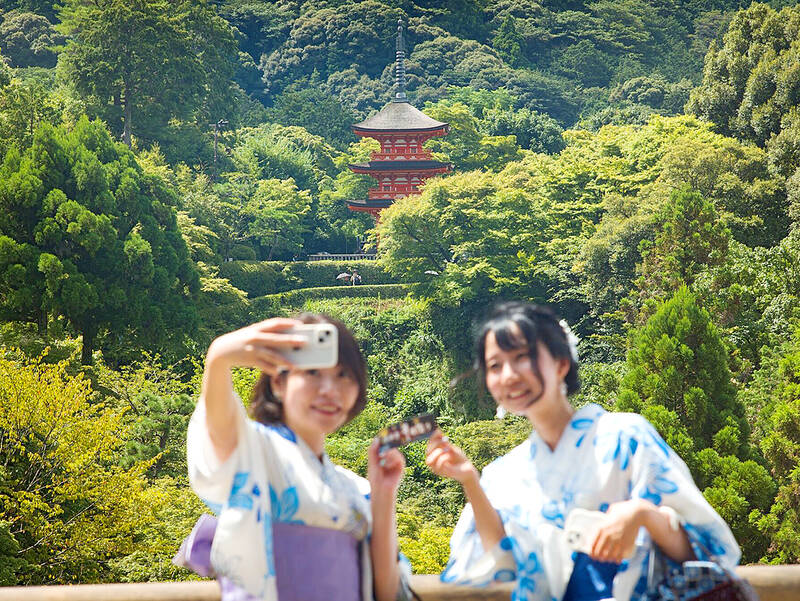They are heavy disks of cast iron that separate us from our subterranean sewage, but in Japan, they are also highly coveted works of art, symbols of regional pride, and now, sources of revenue.
Local authorities are cashing in on the public’s fascination with the country’s decorated manhole covers, with Kyoto now joining a list of locations that are putting obsolete lids up for sale.
The city’s government has said it will sell iron manhole covers to members of the public for the first time, according to the Mainichi Shimbun.

Photo: Bloomberg
At ¥3,000 (US$20) apiece, the covers — manufactured in 1978, 1981 and 1990 — would be considered a steal by collectors keen to own a slice of the city’s history in the form of a 90kg piece of industrial art. According to media reports, new manhole covers cost around ¥60,000 each.
One of the covers features a pattern reminiscent of the wheels of a court carriage — a reference to Kyoto’s time as Japan’s ancient capital. Another has a grid-like motif. All three have acquired a rusty sheen and plenty of scratches during at least three decades of service on Kyoto’s streets.
The eastern city of Maebashi attracted a flood of applications after it put 10 manhole covers on sale in 2017, with almost 200 potential buyers, including from people living outside the city, according to the Kyodo news agency.
Tokorozawa, a city north of Tokyo, is one of several municipalities to have cashed in on the manhole craze. In 2018, it came up with the idea of commercializing the items when it invited firms to advertise on manhole covers in an attempt to finance its heavily indebted sewage management system.
Manhole cover designs from all 17 of Japan’s prefectures have found their way on to collectible cards, keyrings and coasters, as well as T-shirts and tote bags sold by the apparel firm Japan Underground.
Staff visited every prefecture in person to select lid designs and gain permission to reproduce them from local authorities, according to the SoraNews 24 Web site. The firm launched five designs from the northernmost prefecture of Hokkaido in 2021, and completed the range this month with those based on covers from the southernmost prefecture of Okinawa.
Japan’s artistic manhole covers are embellished with thousands of colorful illustrations of everything from local landmarks, famous natives, festivals and flora and fauna. Popular culture also gets a look in, with lids featuring Pokemon characters now adorning paths in most parts of the country.
Enthusiasts, nicknamed “manholers,” indulge their love of the items at an annual manhole summit. Last year’s event was held in Tokorozawa, appropriately enough on the former site of the city’s sewage treatment facility.
According to Kyoto’s water supply and sewerage bureau, the city is home to about 160,000 manhole covers. Those installed on roads have a service life of about 15 years, while those used on pavements last about 30 years, the Mainichi said.
With 1,500 lids replaced every year, the city is expected to continue finding them new owners.
“We’ll sell three to begin with, and if it’s a success, we would like to sell more,” a sewerage bureau official told the newspaper.

The Democratic Progressive Party (DPP), Chinese Nationalist Party (KMT), and the country’s other political groups dare not offend religious groups, says Chen Lih-ming (陳立民), founder of the Taiwan Anti-Religion Alliance (台灣反宗教者聯盟). “It’s the same in other democracies, of course, but because political struggles in Taiwan are extraordinarily fierce, you’ll see candidates visiting several temples each day ahead of elections. That adds impetus to religion here,” says the retired college lecturer. In Japan’s most recent election, the Liberal Democratic Party lost many votes because of its ties to the Unification Church (“the Moonies”). Chen contrasts the progress made by anti-religion movements in

Taiwan doesn’t have a lot of railways, but its network has plenty of history. The government-owned entity that last year became the Taiwan Railway Corp (TRC) has been operating trains since 1891. During the 1895-1945 period of Japanese rule, the colonial government made huge investments in rail infrastructure. The northern port city of Keelung was connected to Kaohsiung in the south. New lines appeared in Pingtung, Yilan and the Hualien-Taitung region. Railway enthusiasts exploring Taiwan will find plenty to amuse themselves. Taipei will soon gain its second rail-themed museum. Elsewhere there’s a number of endearing branch lines and rolling-stock collections, some

This was not supposed to be an election year. The local media is billing it as the “2025 great recall era” (2025大罷免時代) or the “2025 great recall wave” (2025大罷免潮), with many now just shortening it to “great recall.” As of this writing the number of campaigns that have submitted the requisite one percent of eligible voters signatures in legislative districts is 51 — 35 targeting Chinese Nationalist Party (KMT) caucus lawmakers and 16 targeting Democratic Progressive Party (DPP) lawmakers. The pan-green side has more as they started earlier. Many recall campaigns are billing themselves as “Winter Bluebirds” after the “Bluebird Action”

Feb 24 to March 2 It’s said that the entire nation came to a standstill every time The Scholar Swordsman (雲州大儒俠) appeared on television. Children skipped school, farmers left the fields and workers went home to watch their hero Shih Yen-wen (史艷文) rid the world of evil in the 30-minute daily glove puppetry show. Even those who didn’t speak Hoklo (commonly known as Taiwanese) were hooked. Running from March 2, 1970 until the government banned it in 1974, the show made Shih a household name and breathed new life into the faltering traditional puppetry industry. It wasn’t the first